Uncover the Magic and Mysteries of Ubud Monkey Forest in Bali
Unleash your inner adventurer and step into a world where ancient spirituality dances with the untamed spirit of nature. Nestled in the heart of Ubud, Bali's cultural epicenter, the Ubud Monkey Forest is a captivating realm that beckons with its emerald canopy, moss-kissed pathways, and the mischievous charm of its macaque inhabitants. Far more than just a tourist attraction, this sacred sanctuary is a living testament to the harmonious balance between humans and the natural world.
Prepare to be enchanted as you venture deeper into this verdant oasis. Encounter playful primates swinging through the trees, discover hidden temples shrouded in mystique, and feel the pulse of Bali's rich cultural heritage. This comprehensive guide is your key to unlocking the secrets of this extraordinary realm. We'll navigate you through everything from practicalities like entrance fees and transportation tips to unveiling the forest's fascinating history and the intricate social dynamics of its macaque residents.
Whether you're a seasoned explorer, a spiritual seeker, or simply yearning for an unforgettable encounter with nature, this guide will ensure your journey through the Ubud Monkey Forest is nothing short of magical. Find the perfect nearby accommodations to complement your adventure, learn how to interact respectfully with the macaques, and leave with memories that will forever ignite your wanderlust.
So, are you ready to answer the call of the wild? Let's embark on an unforgettable expedition into the heart of the Ubud Monkey Forest, where ancient traditions, natural wonders, and playful primates converge to create an experience that will leave you breathless.
Table of Contents
Entrance Fees
As of this guide's update in January 2025, the entrance fees for Ubud Monkey Forest depend on the day of the week and the visitor's age. Weekdays have lower prices, while weekends are slightly higher.
Weekdays:
Adults: IDR 80,000 (approximately USD $5.71)
Children (3-12 years): IDR 60,000 (approximately USD $4.29)
Weekends:
Adults: IDR 100,000 (approximately USD $7.14)
Children (3-12 years): IDR 80,000 (approximately USD $5.71)
These fees provide access to the entire Ubud Monkey Forest area, including its walking paths, temples, and opportunities to observe the macaques in their natural environment. Keep in mind that children under 3 typically enter for free, though it's always best to check for any changes at the time of your visit.

Address & Accessibility
Ubud Monkey Forest is located in Padangtegal Ubud, along the main road of Jalan Monkey Forest. The address is: Ubud Monkey Forest, Jalan Monkey Forest, Padangtegal Ubud, 80571, Bali, Indonesia.
The forest is easily accessible by road, and visitors can reach it by car, scooter, or taxi. From central Ubud, it's only a 5-minute drive, while from Denpasar, it takes about 45 minutes. Comfortable footwear is recommended for walking through the forest trails.
How to Get There
Reaching Ubud Monkey Forest is easy, with several transportation options depending on your location and preferences:
By Car: The most convenient way to get to Ubud Monkey Forest is by car. If you're staying in areas like Ubud, Seminyak, or Kuta, you can rent a car for a short drive. The roads are in good condition, and parking is available near the forest.
By Taxi: You can take a taxi or use ride-hailing apps such as Grab or Gojek to get to Ubud Monkey Forest. This is ideal if you prefer not to drive, though depending on your location, this option may be slightly more expensive than renting a car.
For a hassle-free experience, consider joining a guided tour with Bali Cheapest Tours. Their day trips to Ubud Monkey Forest often include visits to other must-see destinations like Tegenungan Waterfall, Tirta Empul Temple, and the Tegalalang Rice Terraces, offering a convenient way to explore Bali's cultural and natural wonders.

Ubud Instagram Tour: Bali's Most Scenic Spots
★ ★ ★ ★ ★ (745 Reviews)
Capture Bali’s most stunning locations on a private Instagram tour, including visits to Ubud's iconic landmarks. A perfect trip for those looking to explore Bali’s beauty while filling up their photo galleries. See Details
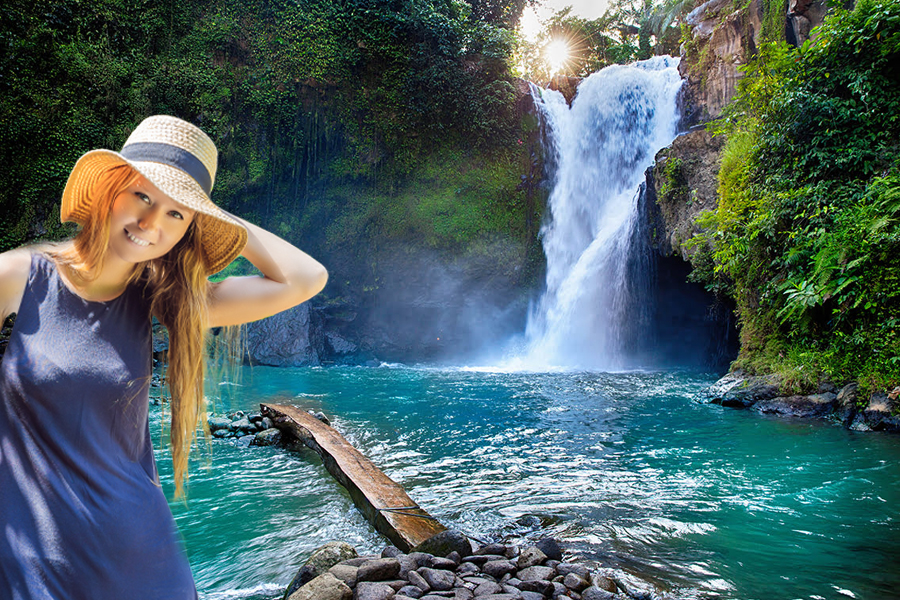
Private Day Trip: Kintamani Volcano, Waterfall, and Ubud
★ ★ ★ ★ ★ (757 Reviews)
Discover Bali on a private day tour featuring the Kintamani Volcano, Tegenungan Waterfall, and Ubud. This tour combines natural wonders with cultural landmarks for an unforgettable experience. See Details
Opening Hours
Ubud Monkey Forest is open to visitors daily from 9:00 AM to 6:00 PM. During these hours, you can explore the lush forest, interact with the macaques, and visit the ancient temples scattered throughout the sanctuary. For a quieter experience, it's best to visit early in the morning or later in the afternoon when the crowds are smaller.
Note that the forest may host special cultural or religious events on certain days, and during these times, some areas may be restricted for worshippers. Visitors are encouraged to be respectful of local traditions during such occasions.
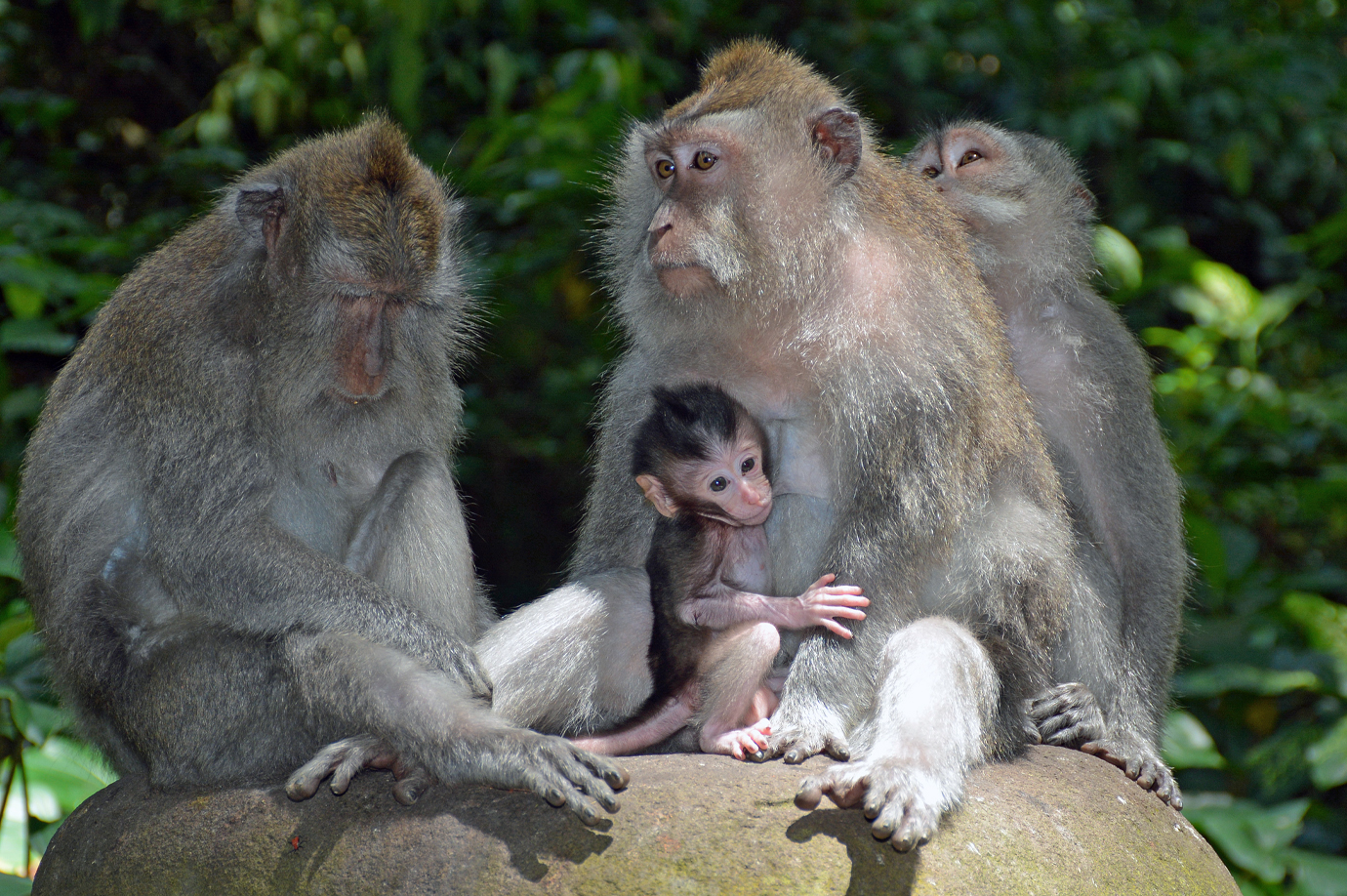
Best Time to Visit
The best time to visit Ubud Monkey Forest is early in the morning, just as the forest opens at 8:30 AM, or later in the afternoon, around 4:00 PM. These times offer a more peaceful experience, with fewer crowds and cooler temperatures, allowing you to fully enjoy the serene surroundings and interact with the macaques in a more relaxed atmosphere.
Visiting during Bali’s dry season, from April to October, is also ideal. The weather is generally pleasant, and you'll be able to explore the forest comfortably without the high humidity or rain typical of the wet season. However, even during the rainy season (November to March), mornings are usually dry, making early visits a great option year-round.
If you're looking to experience Ubud Monkey Forest during a local cultural or religious festival, be mindful that some areas of the forest may be restricted for worshippers. However, this can also be a unique opportunity to witness the local traditions and spiritual ceremonies that take place within the forest’s sacred temples.
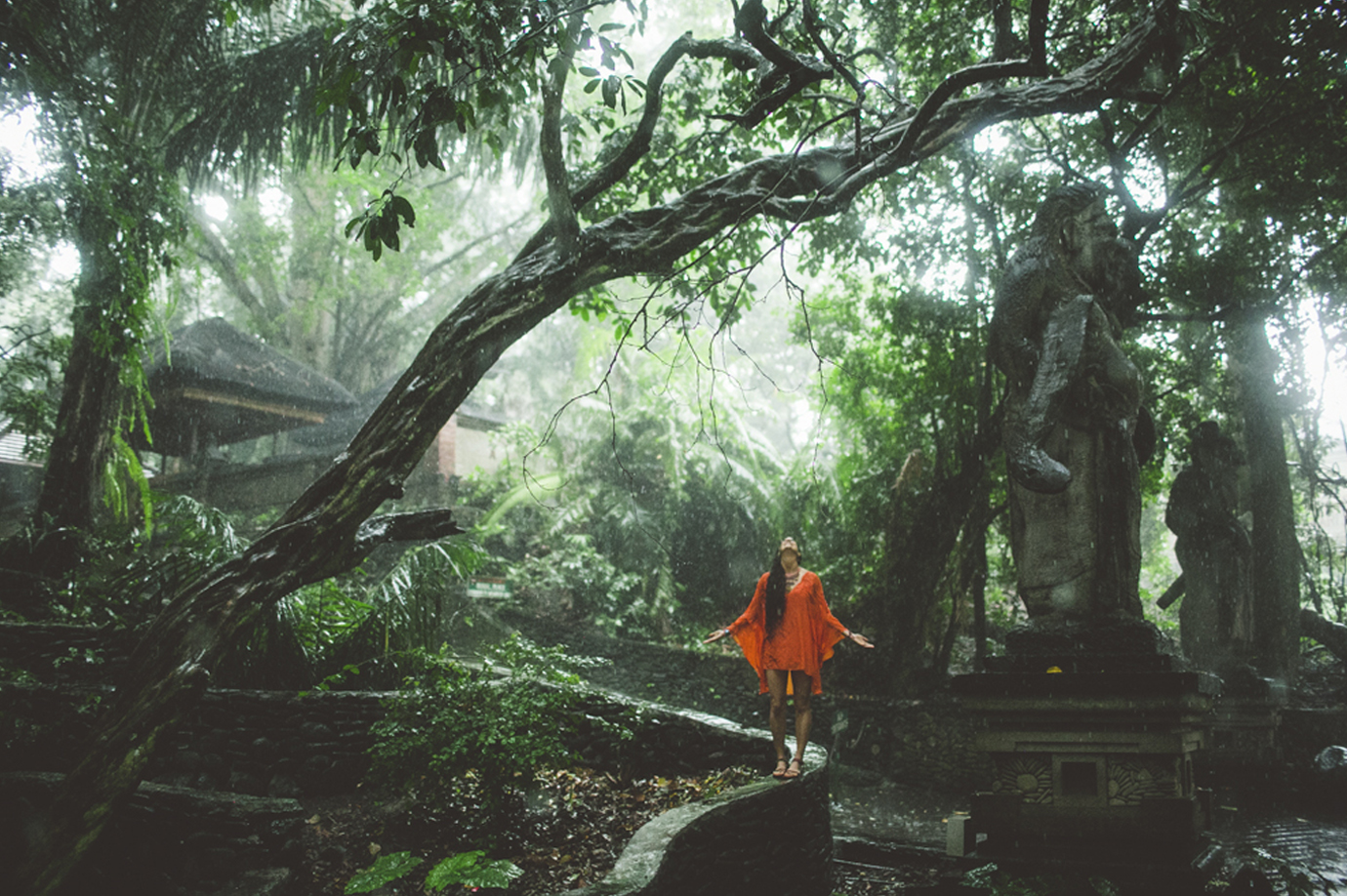
What to See & Do
Ubud Monkey Forest offers visitors a variety of attractions and experiences that blend nature, culture, and spirituality. Here’s a guide to what you can see and do during your visit:
- Explore the Sacred Temples: Ubud Monkey Forest is home to three sacred temples: Pura Dalem Agung Padangtegal, the Holy Spring Temple, and the Prajapati Temple. These ancient structures hold significant cultural and spiritual importance for the Balinese people and are beautifully set amidst the forest, offering a glimpse into Bali’s unique religious traditions.
- Wander Through the Forest: Take a peaceful walk along the well-maintained pathways that wind through the forest. The lush canopy, towering trees, and the sound of nature create a tranquil environment for reflection and relaxation. You’ll also come across moss-covered statues and bridges, enhancing the mystical atmosphere.
- Interact with the Monkeys: The main attraction of Ubud Monkey Forest is the playful long-tailed macaques that inhabit the area. Visitors can observe their social behavior up close as they swing from trees, groom each other, and occasionally interact with tourists. Be mindful of your belongings, as the monkeys are known to be curious!
- Learn About Conservation Efforts: Ubud Monkey Forest is not only a popular tourist destination but also plays an important role in conservation and research. The forest management works to preserve the local ecosystem and protect the macaques, providing educational opportunities for visitors to learn about the wildlife and plant species that thrive in the area.
- Experience Local Spirituality: If your visit coincides with a Balinese Hindu festival or ceremony, you may witness local spiritual practices taking place at the temples. Visitors are welcome to observe, but it’s important to remain respectful of worshippers and any areas reserved for religious activities.
- Capture Stunning Photos: The natural beauty of the forest, combined with the striking temples and playful monkeys, offers endless photo opportunities. Early morning or late afternoon light provides the best conditions for capturing the forest’s enchanting atmosphere.

Nearby Best Hotels
Exploring the wonders of the Ubud Monkey Forest is made even more delightful when you choose from a selection of nearby hotels that offer both comfort and proximity to this enchanting sanctuary. Here are a few options to consider for your stay:
- Ubud Village Hotel: Situated within walking distance of the Ubud Monkey Forest, this charming hotel offers a serene escape surrounded by lush gardens. With traditional Balinese architecture and modern amenities, it provides a tranquil retreat after a day of exploration.
- Alaya Resort Ubud: Just a short distance from the Ubud Monkey Forest, this elegant resort blends contemporary design with traditional Balinese elements. Immerse yourself in the luxurious ambiance and enjoy their spa facilities and authentic dining experiences.
- Royal Kamuela at Monkey Forest: As the name suggests, this boutique hotel is conveniently located near the Monkey Forest. Its private pool villas and personalized services create a luxurious haven in the heart of Ubud.
- Anumana Ubud Bali: Offering a serene atmosphere, this stylish hotel is a short stroll from the Monkey Forest. The tranquil surroundings and modern comforts make it an excellent choice for relaxation.
- Ubud Green Resort Villas: Nestled amid lush landscapes, this resort is a peaceful oasis just minutes away from the Monkey Forest. Its traditional villas and tranquil setting provide a perfect escape from the hustle and bustle.
- Saren Indah Hotel: With a prime location near the Monkey Forest, this hotel offers budget-friendly accommodations without compromising on comfort. Its traditional Balinese architecture and serene setting create a relaxing atmosphere.
These are just a few of the nearby hotel options that cater to various preferences and budgets. Whether you're seeking luxury, traditional charm, or a tranquil hideaway, these accommodations offer a harmonious base from which to explore the natural and cultural marvels of the Ubud Monkey Forest.

Nearby Restaurants
After a day of exploring the Ubud Monkey Forest, you can unwind and enjoy a meal at one of the many nearby restaurants that offer a variety of cuisines. Whether you're craving traditional Balinese dishes or international flavors, there are plenty of dining options within walking distance. Here are a few highly recommended spots:
- Bebek Bengil (Dirty Duck Diner): Famous for its crispy duck, this iconic restaurant offers traditional Balinese cuisine in a scenic setting overlooking rice paddies. It’s just a short walk from Ubud Monkey Forest and is perfect for lunch or dinner after your visit.
- Warung Garasi: This cozy, laid-back restaurant serves authentic Indonesian dishes at affordable prices. Known for its nasi goreng and mie goreng, it's a great spot to refuel with local flavors after a day of exploring.
- Cafe Lotus: Located near the Ubud Palace, this restaurant is known for its beautiful lotus pond and temple views. It serves a range of Indonesian and Western dishes and is ideal for a relaxing dining experience.
- Restaurant Locavore: For a more upscale dining experience, Locavore is a must-visit. This restaurant is renowned for its innovative farm-to-table concept, offering a fine dining menu that highlights local ingredients in creative dishes.
- Warung Babi Guling Ibu Oka: If you want to try Bali’s famous roasted suckling pig, head to this popular warung. Located near Ubud’s center, it’s known for serving some of the best babi guling on the island.
These restaurants offer a range of dining experiences, from casual eateries to fine dining, ensuring that you'll find something to suit your taste and budget after your visit to Ubud Monkey Forest.

Nearby Attractions
While the Ubud Monkey Forest is a captivating destination on its own, the surrounding area offers a wealth of attractions that further enrich your Bali experience. Here are some nearby attractions to consider exploring during your visit:
- Tegallalang Rice Terraces: Immerse yourself in the iconic Tegallalang Rice Terraces, a UNESCO World Heritage Site. These terraces offer breathtaking vistas of meticulously cultivated rice fields, showcasing the artistic and agricultural prowess of the local community.
- Campuhan Ridge Walk: Enjoy a scenic trek along the Campuhan Ridge Walk, offering panoramic views of the lush Ubud countryside. This serene walking trail is perfect for nature lovers and those seeking a peaceful escape from the bustling town center.
- Goa Gajah (Elephant Cave): Uncover the mysteries of Goa Gajah, an ancient archaeological site featuring intricate carvings and a stone meditation cave. This historic gem offers a glimpse into Bali's rich cultural heritage.
- Pura Taman Saraswati: Immerse yourself in the artistic and spiritual ambiance of Pura Taman Saraswati. This water temple is adorned with lotus ponds and intricate carvings, serving as a testament to Bali's devotion to beauty and harmony.
- Ubud Royal Palace: Visit the Ubud Royal Palace (Puri Saren Agung), a historical landmark in the heart of Ubud. The palace showcases traditional Balinese architecture and serves as a cultural center, often hosting traditional dance performances in the evenings.
- Ubud Art Market: Delve into the vibrant arts and crafts scene of Ubud at the Ubud Art Market. Here, you can find an array of handicrafts, textiles, jewelry, and souvenirs that showcase Bali's artistic prowess.
- Tegenungan Waterfall: Experience the natural beauty of Bali by visiting Tegenungan Waterfall. This picturesque waterfall is surrounded by lush vegetation, providing a refreshing escape from the tropical heat.
Exploring these nearby attractions alongside your visit to the Ubud Monkey Forest allows you to immerse yourself in Bali's rich cultural heritage, stunning landscapes, and artistic treasures. Each destination contributes to a holistic and unforgettable Bali experience.
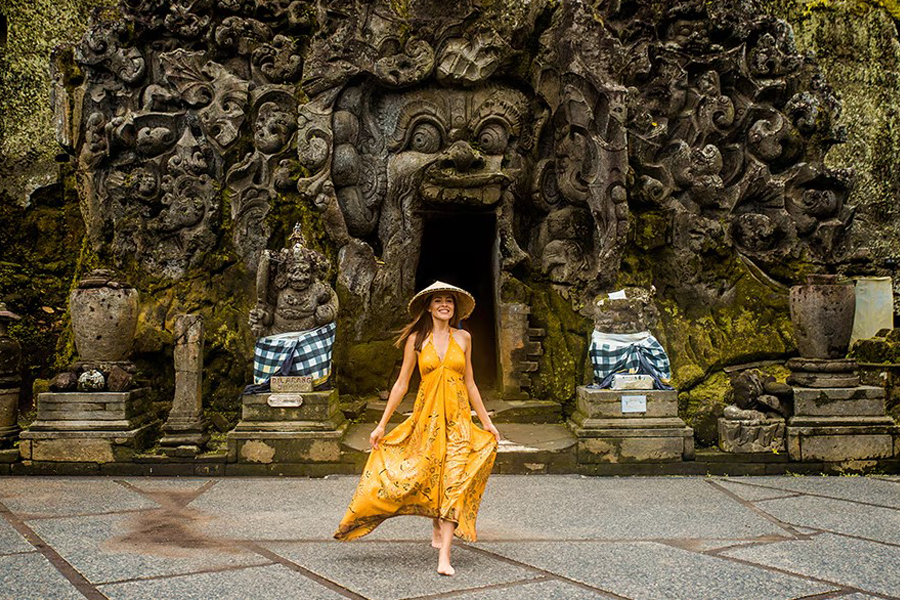
Historical Background
The Ubud Monkey Forest, officially known as the Sacred Monkey Forest Sanctuary, is deeply rooted in Balinese history and spirituality. Established in the 14th century, the forest is more than just a tourist attraction—it is a sacred site for the local community, embodying the strong connection between humans, nature, and the spiritual realm.
At the heart of the forest are three ancient Hindu temples: Pura Dalem Agung Padangtegal, the Holy Spring Temple, and the Prajapati Temple. These temples are dedicated to various deities and play a significant role in local religious ceremonies. The most prominent of the three, Pura Dalem Agung, is dedicated to Shiva, the god of destruction and transformation. The temples are used regularly by local Balinese Hindus for worship and rituals, particularly during full moon ceremonies and other important spiritual events.
The forest itself has long been a place of refuge and sanctuary. Historically, it served as a natural site for reflection, meditation, and spiritual practices for the local villagers. The combination of towering trees, ancient temples, and the presence of the long-tailed macaques create a unique atmosphere that has been preserved for centuries.
In addition to its spiritual significance, Ubud Monkey Forest also plays a critical role in local conservation efforts. The forest is home to over 700 long-tailed macaques and numerous rare plant species. For the local community, it represents a harmonious balance between preserving nature and maintaining spiritual practices, which have been passed down from generation to generation.
Today, the Ubud Monkey Forest continues to be a sacred and historical landmark, providing both locals and visitors with a deep connection to Bali's cultural heritage and spiritual beliefs.

Mythology & Legends
The Ubud Monkey Forest is not just a physical sanctuary; it is steeped in mythology and legends that reflect the deep spiritual and cultural beliefs of the Balinese people. The forest and its temples are intertwined with ancient tales that continue to influence the local community’s understanding of the spiritual world.
One of the most prominent legends associated with the forest revolves around the Hindu god Hanuman, the monkey god known for his strength, loyalty, and courage. Hanuman is a central figure in the Ramayana, an ancient Indian epic that is still performed in Bali today through traditional dance and theatre. According to the Ramayana, Hanuman played a crucial role in helping Lord Rama defeat the demon king Ravana and rescue his wife, Sita. The monkeys in Ubud Monkey Forest are often seen as descendants or spiritual representations of Hanuman’s army, which is why they are respected and protected in this sacred space.
Another key myth involves the forest itself. Locals believe that the Ubud Monkey Forest is inhabited by protective spirits and ancestral beings who guard the temples and surrounding areas. These spirits are said to maintain the balance between the natural and spiritual worlds, ensuring harmony within the forest. It is believed that the forest is a place where the veil between the physical and spiritual realms is thin, making it a site of powerful energy and reverence.
In Balinese culture, every element of nature has spiritual significance, and the trees within the forest are considered sacred. One such tree, the banyan, is thought to be a powerful source of protection and spiritual energy. According to local lore, the roots of these trees extend deep into the earth, connecting the physical world with the underworld, while their branches reach up to the heavens. Many Balinese believe that these trees house spirits, and they often leave offerings at the base of the trees to appease these beings.
Visitors are encouraged to treat the forest and its inhabitants with respect, not only for the monkeys but also for the spirits that are believed to reside within. The rituals, offerings, and ceremonies held within the temples are ways to honor the legends and keep the balance between humans, nature, and the divine intact.
The myths and legends surrounding Ubud Monkey Forest make it more than just a natural site—it is a living, breathing representation of Bali’s unique blend of religion, folklore, and cultural traditions. For many locals, it remains a place where the divine and the earthly meet in a harmonious coexistence.
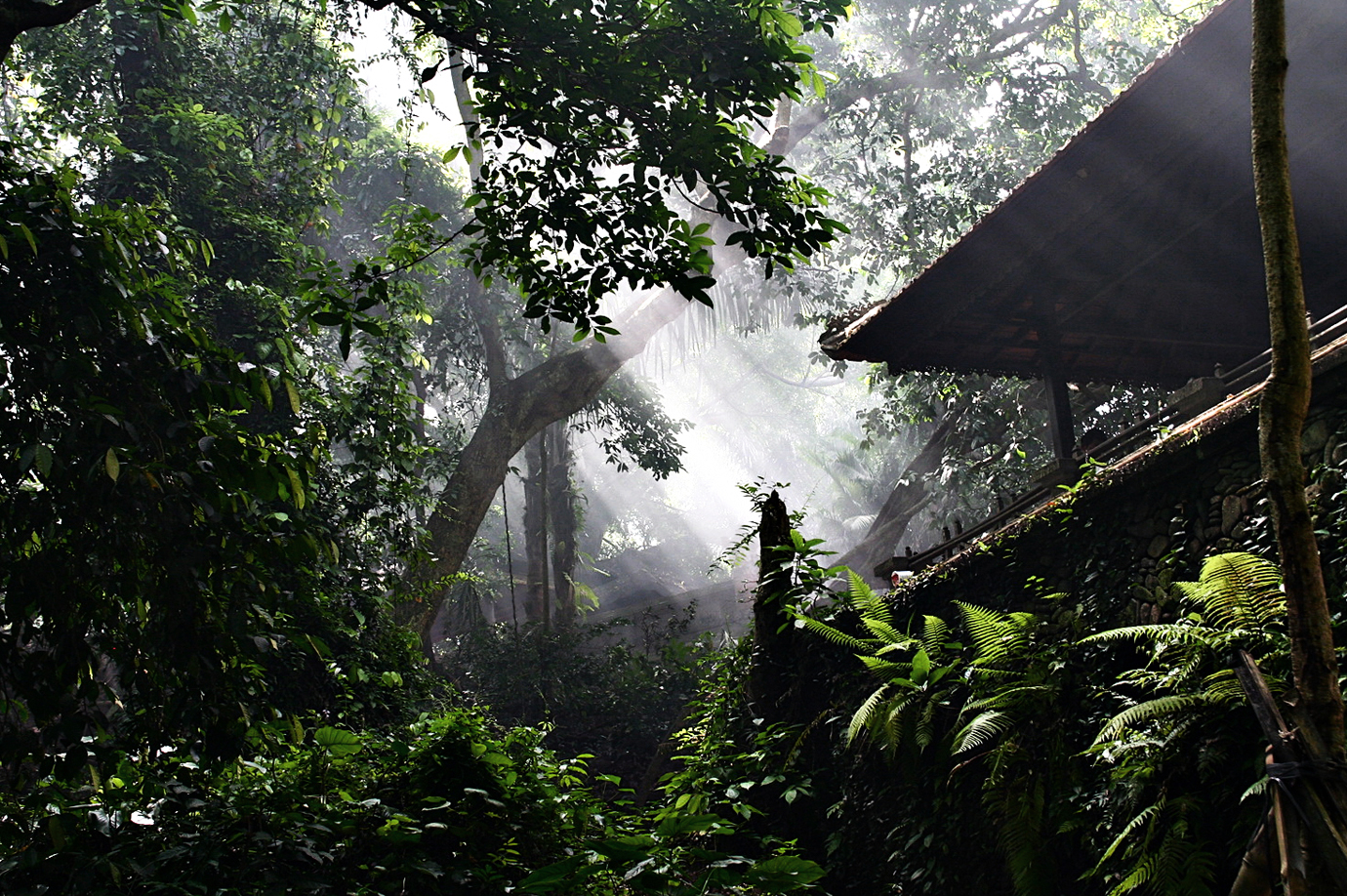
The Monkeys Species
The type of monkeys that live in the Sacred Monkey Forest Sanctuary, also known as the Ubud Monkey Forest, are Balinese long-tailed monkeys, scientifically called Macaca fascicularis. In English, they are commonly referred to as macaques. These monkeys are native to the region and are an important part of the forest's ecosystem and cultural significance.
Monkey Population and Social Structure
There are approximately 1,260 monkeys living within the Ubud Monkey Forest area. These monkeys are divided into 10 distinct social groups:
- Temple Group
- Selatan Group
- New Forest Group
- Ashram Group
- Central Group
- East Group
- Michelin Group
- Utara Group
- Cemetery Group
- Atap Group
Each of these groups consists of 110 to 230 monkeys, and the social dynamics within each group are complex, with distinct hierarchies and roles.
Age Groups and Developmental Stages
The monkeys in the sanctuary are categorized into different age and development groups. These include:
- Infants (0 – 1 year): The youngest members of the groups, these monkeys are heavily dependent on their mothers.
- Juvenile 1 (1 – 2 years): Monkeys in this age group are beginning to gain independence and explore their surroundings.
- Juvenile 2 (2 – 4 years): Older juveniles who are still developing their social skills and learning their place in the group hierarchy.
- Sub Adult Males (4 – 6 years): Young males approaching adulthood but not yet fully dominant or mature.
- Adult Females (> 4 years): Fully grown females who are essential to the social and reproductive structure of the groups.
- Adult Males (> 6 years): Mature males who often take on dominant roles and are responsible for protecting the group.
The monkeys in Ubud Monkey Forest are a vital part of the ecosystem and social fabric of the sanctuary, making them both fascinating and important to the area's biodiversity and culture.

Why You Must Visit?
If you come to Bali, Ubud Monkey Forest should be high on your list of places to visit. This iconic sanctuary is not only a haven for nature lovers but also a significant cultural and spiritual site for the Balinese people. Here’s why visiting Ubud Monkey Forest will make your trip to Bali truly unforgettable:
1. Deep Spiritual Connection: Ubud Monkey Forest is not just a tourist spot; it is deeply intertwined with the spirituality of the Balinese people. The forest is home to sacred temples that have been an essential part of Bali's religious landscape for centuries. Walking through the forest, you'll feel the sacred energy that makes it a special spiritual sanctuary.
2. Unique Wildlife Encounter: Ubud Monkey Forest is famous for its playful long-tailed macaques, which you can observe in their natural habitat. These monkeys are a key attraction, providing a rare opportunity to witness Bali's wildlife up close. Their mischievous behavior adds excitement and charm to your visit.
3. Cultural Immersion: As you explore Ubud Monkey Forest, you're also stepping into the heart of Ubud's cultural hub. Located near many other cultural sites such as the Ubud Art Market and traditional Balinese performance venues, the forest allows visitors to experience a blend of nature and culture that is unique to Bali.
4. Natural Beauty: The serene surroundings of Ubud Monkey Forest, with its towering trees, tropical plants, and ancient stone carvings, create a sense of awe. It’s a beautiful representation of Bali’s natural allure, making it an ideal spot to enjoy both nature and history.
5. Escape from the Crowds: While Bali is known for its busy beaches, Ubud Monkey Forest offers a tranquil escape. The peaceful atmosphere and lush greenery provide a relaxing break from the hustle and bustle of Bali’s tourist hotspots, making it a perfect place to unwind and reconnect with nature.
Ubud Monkey Forest is a must-visit destination for anyone traveling to Bali. It perfectly combines spirituality, culture, wildlife, and nature, offering an unforgettable experience that showcases the essence of the island. Whether you're there to explore or relax, your time in the forest will leave you with memories of Bali's rich heritage.
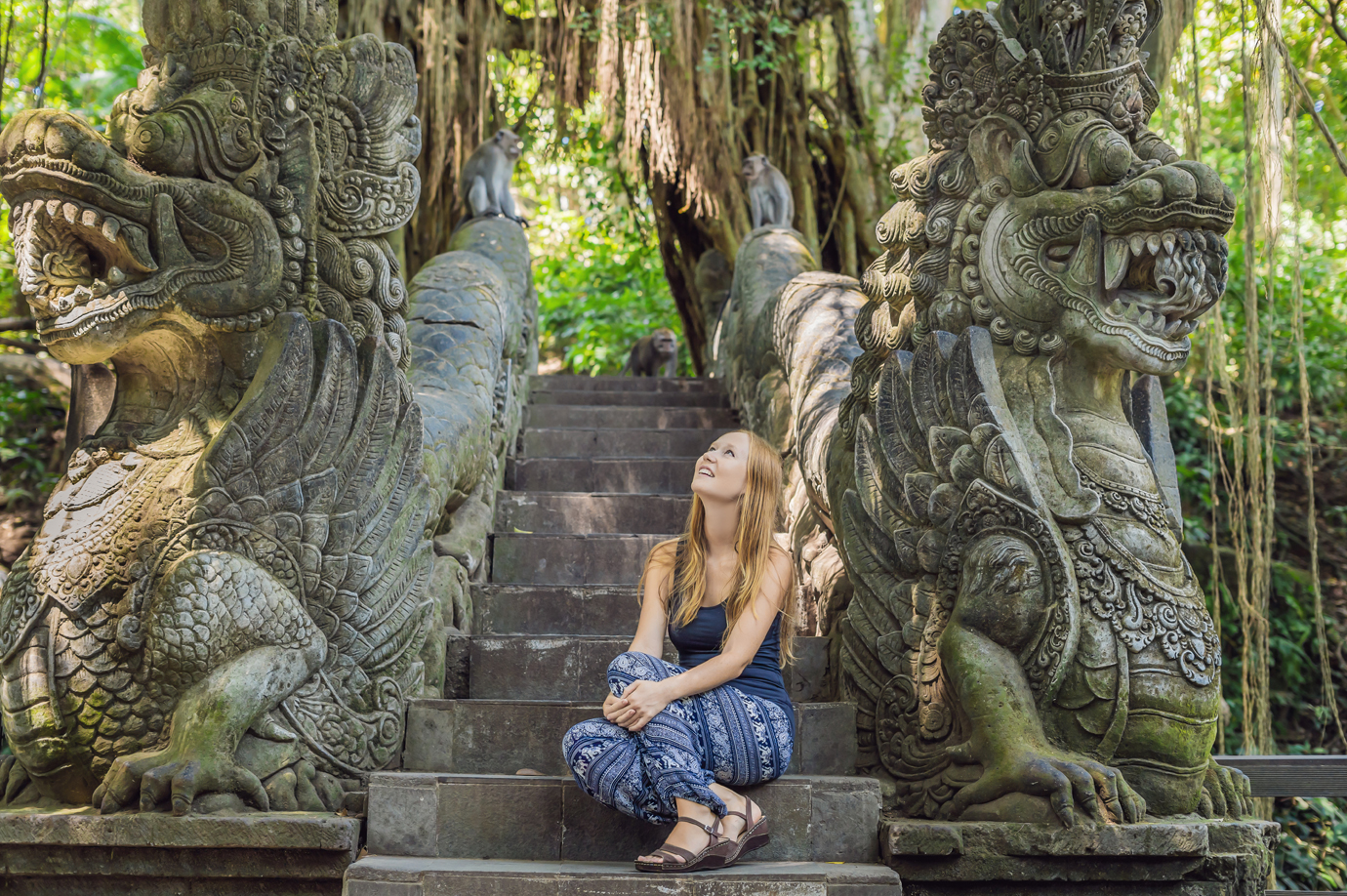
Know Before You Go
Here are some important things to know before visiting Ubud Monkey Forest to ensure you have a smooth and enjoyable experience:
1. Entry Fees: There is a small entrance fee to visit Ubud Monkey Forest. The funds contribute to the maintenance of the forest and the care of the monkeys. It’s recommended to check the current fee before your visit to be prepared.
2. Respect the Monkeys: The long-tailed macaques are entertaining to watch, but it’s crucial to remember they are wild animals. Avoid direct eye contact, don’t feed them, and secure your belongings, as the monkeys are known for their curiosity and playfulness.
3. Best Time to Visit: The best times to visit are early in the morning or late afternoon when the weather is cooler, and the forest is less crowded. Visiting at these times also offers better opportunities to observe the monkeys in a peaceful setting.
4. Dress Appropriately: Since Ubud Monkey Forest contains sacred temples, it’s important to dress modestly. Make sure to cover your shoulders and knees when entering temple areas to show respect for local customs.
5. Bring Water and Sunscreen: The weather in Ubud can get hot, so be sure to stay hydrated by bringing water and protect yourself from the sun by applying sunscreen before exploring the forest.
Additional Guidelines for Your Safety and Enjoyment
- Stay Calm, Don’t Panic: If a monkey gets too close, it’s important to stay calm. Sudden movements can make them more curious or nervous, so just remain still and composed.
- Never Run: Running may provoke the monkeys to chase you, thinking it’s a game. Walk calmly and avoid making any quick movements that could catch their attention.
- Avoid Eye Contact: Monkeys might see direct eye contact as a challenge or threat. It’s better to observe them without looking directly into their eyes.
- No Food or Drinks Allowed: Monkeys have an excellent sense of smell and will try to snatch any food or drinks. It’s best not to bring any, or they’ll be quick to find it!
- Leave Plastic or Paper Bags Behind: Monkeys often mistake bags for food containers, so avoid bringing any plastic or paper bags that might attract their attention.
- Secure Your Valuables: Monkeys love shiny objects, so keep sunglasses, hats, and phones secure. It’s a good idea not to bring valuables at all to avoid any unwanted monkey business!
- Don’t Touch or Disturb the Monkeys: As tempting as it may be, do not try to touch or grab the monkeys. Let them roam freely without interference from visitors.
- No Feeding the Monkeys: Feeding the monkeys is prohibited. They are fed properly by caretakers, and giving them snacks like peanuts, candy, or bread can harm their health.
- Watch Your Children: Keep a close eye on your children, making sure they understand how to act around the monkeys. A little extra caution helps everyone enjoy their visit safely.
By keeping these tips and guidelines in mind, you’ll be well-prepared for your visit to Ubud Monkey Forest, ensuring a safe, memorable, and respectful experience in this unique sanctuary.
Author
This guide to Ubud Monkey Forest, carefully written by the Bali Cheapest Tours & team, reveals the unique blend of nature, spirituality, and wildlife that make this sanctuary one of Bali’s must-visit attractions.
Picture yourself walking through lush greenery, surrounded by playful monkeys, ancient temples, and towering trees. The serene beauty and cultural significance of Ubud Monkey Forest provide an unforgettable experience, offering both adventure and a deeper understanding of Bali's natural and spiritual landscapes.
Planning Your Bali Trip?
Let our expert team create an unforgettable Balinese experience for you. Contact us today to explore our personalized tour packages.
Bali offers magical experiences for every traveler. Don’t wait—start your Bali adventure today and make lasting memories!
